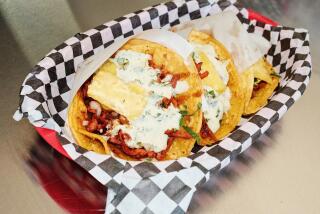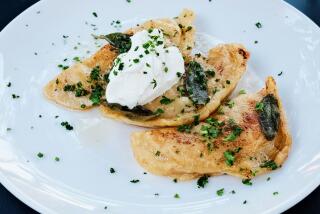Bar Talk : Multilingual Barkeeps Learn Nuances of ‘Set ‘Em Up, Joe’
Tomas Lau, the operator of this city’s only multilingual bartender’s school, is one-quarter French, one-quarter Chinese, one-half Mexican and can say, “Hi, what’ll it be?” in Korean and Japanese.
Not that language skills are crucial when it comes to understanding drink orders.
“You know how to say ‘whiskey’ in Spanish?” Lau asked by way of explanation. “ ‘Whiskey.’ Same with ‘Scotch.’ They’re names--you don’t translate them.”
Lau has 40 prospective pourers taking classes in their native tongues of English, Chinese and Spanish. But although he and his two instructors impart useful English phrases, the main language taught is bar talk: the difference between a Pink Lady and a Green Godmother, how to decipher cocktail waitresses shorthand and the Three Subjects Never to Discuss With Customers.
The curriculum--ever expanding because of the increasing numbers of nationalities elbowing up to bars here--covers 130 drink recipes, including such foreign concoctions as a Mandarin Cocktail or a Cuba Libre.
The apprentice mixologists learn that if a waitress shouts, “Four rums Coke seven two Cuba!” she means one rum Coke, one with 7-Up and two Cuba Libres.
Cultural considerations are emphasized, too.
“Say three elderly Oriental ladies come in and don’t know how to call for drinks,” Lau said. “Then you (the bartender) might recommend a Pink Squirrel because Oriental ladies like almond-tasting drinks.”
Pupils enrolled in the 120-hour, $550 course are also graded in such subjects as posture (“hands behind your back; no folded arms”), personality (smiling is required), pouring, fruit decoration (a crucial component of tropical drinks) and how to make change and tips.
“If the change is a dollar, put four quarters down and lay each one flat on the bar,” the schoolmaster advised. “If the customer has a companion, he probably won’t want to be grabbing for all of them in front of her.”
The art of silence is also taught.
“Bartenders should be listeners,” he said. “People have lots of problems they want to talk about. Don’t interrupt them. And never talk about three things: politics, race or religion.”
Except for the 14 schoolroom-type seats in the center of the room for wine classes, Lau’s Spring Street school resembles a huge saloon, with three bar counters (traditional brown Formica) in a U-shaped pattern.
Eight young men in vests and ties stood behind the bars one recent afternoon, quietly washing glasses, wiping counters and concocting drinks. Lau forbids his apprentice bartenders to read horse-racing charts during class.
The bars had all the trimmings: rows of liquor bottles, neon beer signs, cash registers and credit card machines poised for action--everything except customers.
The no-smoking sign was sort of a giveaway, too. In fact, the universal saloon smell was missing altogether.
“We have absolutely no liquor on the premises,” Lau explained. “We use colored water instead. I judge the drinks by their appearance, their color. Also, the students have to pass written tests on the recipes.”
Lau, who once served drinks at such now-vanished Sunset Strip spots as Ciro’s and the Mocambo, said he opened the International School of Bartending in 1965 “because I realized this was becoming an international city.” It’s one of three such establishments in the county.
One of Lau’s walls is decorated with photos of graduates; he said 80% find jobs, most in the 3,383 lounges and restaurant bars licensed to sell cocktails in the county. (Dropouts can always go to work for the 1,500 or so area beer-and-wine joints.)
“A lot of them (the students) come from low-paying jobs, like factories,” Lau said. “This is like a luxury job for them. You might not get rich, but you wear a necktie, and you get a regular paycheck.”
Claudio Godoy, who will be taking his bar examination soon, agreed.
Godoy paused in his speed drill--he was practicing making a rum Coke in less than 10 seconds--to say that tending bar would be “cleaner than what I do now--handling produce in Chinatown.” Plus, he said, a nighttime job would enable him to study engineering in college.
Lau’s foreign-born students have included a South Korean who returned to Seoul to establish his own bartender’s school, an emigrant barkeep from Portugal who discovered that his repertoire of eight drinks was fine for Lisbon but inadequate for Los Angeles and Robert Sun, a Taiwanese who recently bought a restaurant in Syracuse, N.Y.
Sun, standing down the bar from Godoy, assembled an ersatz Ramos Fizz while explaining that he had heard about the course during a visit to his brother here. He said he enrolled in case his bartender ever failed to show up for work or quit suddenly (a not-unheard-of event in the business).
Lau examined Sun’s Ramos Fizz, which consisted of half a glass of brown water topped by a mixture of soda water and rose-scented hand lotion.
“Very nice,” the schoolmaster said.
Just enough lanolin base.
More to Read
Eat your way across L.A.
Get our weekly Tasting Notes newsletter for reviews, news and more.
You may occasionally receive promotional content from the Los Angeles Times.









